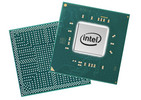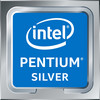Intel Celeron N4020 vs Intel Celeron N4000 vs Intel Pentium Silver J5040
Intel Celeron N4020
► remove from comparison
The Intel Celeron N4020 is a slow dual-core processor (SoC) of the Gemini Lake refresh product family; as such, it is designed for use in laptops and mini-PCs of the most affordable flavor. The Celeron was launched in Q4 2019. Its CPU cores run at 1.1 GHz to 2.8 GHz, the latter being a moderate 200 MHz upgrade over the preceding N4000 chip. Other key specs include a DDR4/LPDDR4 memory controller (up to 2,400 MHz and up to 8 GB, with independent reports claiming as much as 32 GB will work just fine) and an integrated UHD 600 graphics adapter.
Architecture & Features
Just like Apollo Lake family products, the ever-popular N3350 included, the N4020 is manufactured on a really old, as of late 2023, 14 nm process. What makes the newer Celerons different are the slightly improved processor cores with double the L2 cache and also, somewhat counterintuitively, a reduction in physical size.
The Goldmont Plus microarchitecture is not much different from what was used in Gemini Lake processors like the N4000. A relatively large 4 MB L2 cache features prominently on the rather short list of N4020's strong sides, allowing for a marginal increase in performance-per-MHz figures compared to processors of previous generations. Still, Gemini Lake refresh processors are a clear step down from Core i3/i5/i7/i9 series processors, both in performance and in features.
The N4020 has six PCI-Express 2.0 lanes at its disposal. While very few N4020-based SBCs, nettops and laptops feature an NVMe M.2 slot, you can use an NVMe SSD as a boot drive with this processor (read/write rates will be limited to 2 GB/s, though). Furthermore, partial Wi-Fi 5 support is built into the CPU. The Celeron also supports up to eight USB 3.0 ports and two SATA III storage devices.
Please note this is not a user-replaceable CPU. They solder it straight to the motherboard for good (BGA1090 socket interface).
Performance
While slightly faster than the outgoing Celeron N4000, the average N4020 in our extensive database only just manages to match the N6211, as far as multi-thread performance is concerned. These three chips deliver multi-thread CB R15, CB R20 and CB R23 scores that are so low, they lag behind a single-thread score of any half-decent CPU such as an i5-1135G7. In other words, these Celeron N chips are good enough for basic tasks only such as word processing and Web browsing with two or three tabs open at a time.
The Celeron N4120, a quad-core chip with a similar name, has little trouble leaving the N4020 behind in most workloads - which is not to say it is a fast CPU.
Jacking the long-term power limit value up to something like 9 W will help improve system responsiveness noticeably.
Graphics
The UHD Graphics 600 is based on Intel's Generation 9 architecture, much like the HD Graphics 520 or the UHD Graphics 615 or other widespread Intel iGPUs found in Core i3/i5/i7/i9 processors of generations six to ten.
Just like the HD Graphics 500, the UHD Graphics 600 is DX12 compatible. The iGPU's 12 EUs can run at up to 650 MHz. The Iris Plus G7 iGPU that certain 10th Gen Ice Lake processors have packs 64 EUs, for reference. As a low-end solution, UHD Graphics 600 will let you play some seriously old titles, but that's about as far as its talents go.
Perhaps more importantly, this graphics solution can drive up to 3 monitors with resolutions as high as 4096x2160@60. Furthermore, it will have no trouble HW-decoding AVC, HEVC and VP9-encoded videos. The newer AV1 codec will be decoded via software, with the limited CPU horsepower imposing a limit on video resolutions that can be played back without stuttering. 1080p60 videos are out of reach while 720p25 videos run fine, to give you an example.
Power consumption
The low 6 W TDP (also known as the long-term Power Limit) makes it easy for laptop makers to ditch the fan. Performance sustainability will be poor unless the long-term Power Limit is set to a value higher than the default 6 W and a fan is available to aid in heat dissipation.
The Celeron N4020 is built with one of the old 14 nm Intel processes for poor, as of mid 2023, energy efficiency.
Intel Celeron N4000
► remove from comparison
The Intel Celeron N4000 is a dual-core SoC designed for affordable laptops and mini-PCs and was announced late 2017. It runs at 1.1 GHz to 2.6 GHz (Single Core Burst, Multi Core Burst maxes out at 2.5 GHz) and is based on the Gemini Lake platform. Similar to the Apollo Lake predecessor, the chip is manufactured on a 14 nm process with FinFETs but offers slightly improved processor cores, double the amount of L2 cache, all in a smaller package. Partial Wi-Fi 5 support is baked into the chip. Besides two CPU cores, the chip also includes a DirectX 12 capable GPU as well as a DDR4/LPDDR4 memory controller (dual-channel, up to 2400 MHz). The SoC is not replaceable as it is directly soldered to the mainboard.
Architecture
The processor architecture was slightly reworked and is now called Goldmont Plus. It features a larger L2 cache (4 MB). That means the per-clock-performance should be a bit better, but not anywhere near the Core CPUs like Kaby Lake Y.
Performance
The average N4000 in our database only just matches the Core i5-4300Y, a fairly old dual-core processor of nearly the same energy efficiency, in multi-thread performance. In other words, the Celeron is a very slow processor that's good enough for the most basic of tasks only. Expect long load times no matter the app.
Graphics
The UHD Graphics 600 (Gemini Lake) is based on Intel's Generation 9 architecture, which supports DirectX 12 and is also used for the Kaby Lake / Skylake / Apollo Lake graphics adapters (like HD Graphics 520). Equipped with 12 EUs and a clock of up to 650 MHz, the performance should be roughly on par with the older HD Graphics 500 (Apollo Lake).
The chip also includes an advanced video engine with hardware support for the playback of VP9 and H.265 (8-bit color-depth).
Power consumption
Like most other N-class Intel chips, the Celeron N4000 has a 6 W TDP (also known as the long-term power limit). This is not much at all, allowing laptop makers to build passively cooled laptops, tablets, mini-PCs around the chip. The SoC can briefly consume up to 15 W, though, depending on how a system is configured.
Last but not the least, this Celeron is manufactured on one of the old 14 nm Intel processes leading to poor, as of early 2023, energy efficiency.
Intel Pentium Silver J5040
► remove from comparison
The Intel Pentium Silver J5040 is a quad-core SoC primarily for inexpensive mini-PCs and was announced late 2019. It runs at 2 GHz (base) to 3.2 GHz (single core burst) and is based on the Gemini Lake platform (refresh). Similar to the Apollo Lake predecessor, the chip is manufactured in a 14 nm process with FinFETs but offers slightly improved processor cores, double the amount of L2 cache, a smaller package, a better GPU architecture and a partly integrated WiFi support. Besides four CPU cores, the chip also includes a DirectX 12 capable GPU as well as a DDR4/LPDDR4 memory controller (dual-channel, up to 2400 MHz). The SoC is not replaceable as it is directly soldered to the mainboard.
Architecture
The processor architecture is still called Goldmont Plus. Compared to the older Goldmont cores in Apollo Lake, they feature an increased level 2 cache (to 4 MB). That means the per-clock-performance should be a bit better, but not near the Core CPUs like Kaby Lake Y.
Performance
Thanks to the higher clock speed and TDP, the Pentium J5040 is slightly faster than the mobile counterpart, the Pentium Silver N5030. Compare to AMD, it ranks on average slightly higher compared to the Athlon Silver 3050e (Zen based Dual-Core) that wins in single-core tests but looses out in multi-threaded tests. Intel Core i3 from 2019 (like the i3-1005G1) are clearly faster and win even in multi-threaded tests easily although being only dual-core CPUs.
GPU Performance
The UHD Graphics 605 (Gemini Lake) is based on Intel's Gen9 architecture, which supports DirectX 12 and is also used for the Kaby Lake / Skylake / Apollo Lake graphics adapters (like HD Graphics 520). Equipped with 18 EUs and a clock of up to 800 MHz, the performance should be roughly on par with the older HD Graphics 5300 and HD Graphics 505 (Apollo Lake).
The chip also includes an advanced video engine with hardware support for the playback of VP9 and H.265 material (8-bit color-depth).
Power Consumption
The J-variant of the Gemini Lake SoCs are specified at 10W TDP and therefore higher than the mobile N variants (6 Watt).
| Model | Intel Celeron N4020 | Intel Celeron N4000 | Intel Pentium Silver J5040 | ||||||||||||||||||||||||||||||||||||||||||||||||||||||||||||||||||||||||
| Series | Intel Gemini Lake | Intel Gemini Lake | Intel Gemini Lake | ||||||||||||||||||||||||||||||||||||||||||||||||||||||||||||||||||||||||
| Codename | Gemini Lake refresh | Gemini Lake | Gemini Lake Refresh | ||||||||||||||||||||||||||||||||||||||||||||||||||||||||||||||||||||||||
| Series: Gemini Lake Gemini Lake Refresh |
|
|
| ||||||||||||||||||||||||||||||||||||||||||||||||||||||||||||||||||||||||
| Clock | 1100 - 2800 MHz | 1100 - 2600 MHz | 2000 - 3200 MHz | ||||||||||||||||||||||||||||||||||||||||||||||||||||||||||||||||||||||||
| L2 Cache | 4 MB | 4 MB | 4 MB | ||||||||||||||||||||||||||||||||||||||||||||||||||||||||||||||||||||||||
| Cores / Threads | 2 / 2 | 2 / 2 | 4 / 4 | ||||||||||||||||||||||||||||||||||||||||||||||||||||||||||||||||||||||||
| TDP | 6 Watt | 6 Watt | 10 Watt | ||||||||||||||||||||||||||||||||||||||||||||||||||||||||||||||||||||||||
| TDP Turbo PL2 | 15 Watt | ||||||||||||||||||||||||||||||||||||||||||||||||||||||||||||||||||||||||||
| Technology | 14 nm | 14 nm | 14 nm | ||||||||||||||||||||||||||||||||||||||||||||||||||||||||||||||||||||||||
| Socket | BGA1090 | BGA1090 | FCBGA1090 | ||||||||||||||||||||||||||||||||||||||||||||||||||||||||||||||||||||||||
| Features | DDR4-2400/LPDDR4-2400 RAM, PCIe 2, MMX, SSE, SSE2, SSE3, SSSE3, SSE4.1, SSE4.2, VMX, SMEP, SMAP, MPX, EIST, TM1, TM2, Turbo, AES-NI, RDRAND, RDSEED, SHA, SGX | DDR4-2400/LPDDR4-2400 RAM, PCIe 2, MMX, SSE, SSE2, SSE3, SSSE3, SSE4.1, SSE4.2, SMEP, SMAP, MPX, EIST, TM1, TM2, Turbo, AES-NI, RDRAND, RDSEED, SHA, SGX | Intel UHD Graphics 605 (18 EUs, 200 - 750 MHz), Quick Sync, AES-NI, max. 8 GB Dual-Channel DDR4/LPDDR4-2400 | ||||||||||||||||||||||||||||||||||||||||||||||||||||||||||||||||||||||||
| iGPU | Intel UHD Graphics 600 (200 - 650 MHz) | Intel UHD Graphics 600 (200 - 650 MHz) | Intel UHD Graphics 605 (250 - 800 MHz) | ||||||||||||||||||||||||||||||||||||||||||||||||||||||||||||||||||||||||
| Architecture | x86 | x86 | x86 | ||||||||||||||||||||||||||||||||||||||||||||||||||||||||||||||||||||||||
| Announced | |||||||||||||||||||||||||||||||||||||||||||||||||||||||||||||||||||||||||||
| Manufacturer | ark.intel.com | ark.intel.com | www.intel.com | ||||||||||||||||||||||||||||||||||||||||||||||||||||||||||||||||||||||||
| max. Temp. | 105 °C | 105 °C | |||||||||||||||||||||||||||||||||||||||||||||||||||||||||||||||||||||||||
| $107 U.S. |


 Deutsch
Deutsch English
English Español
Español Français
Français Italiano
Italiano Nederlands
Nederlands Polski
Polski Português
Português Русский
Русский Türkçe
Türkçe Svenska
Svenska Chinese
Chinese Magyar
Magyar
